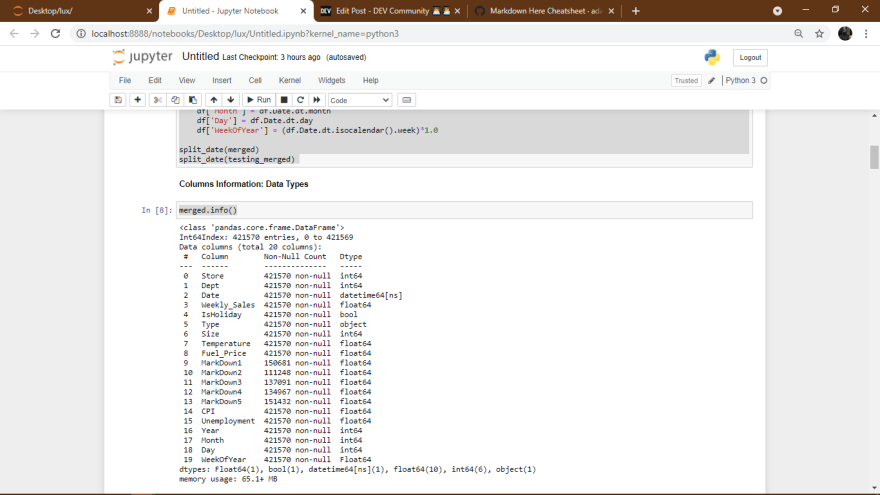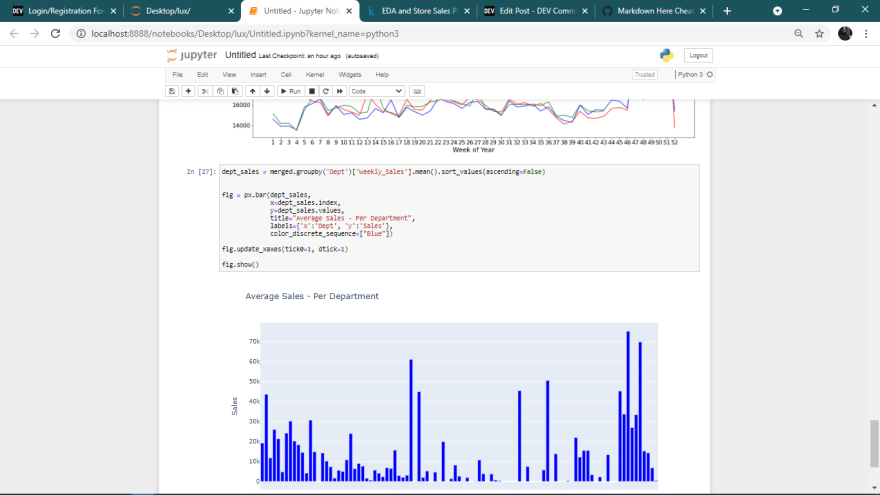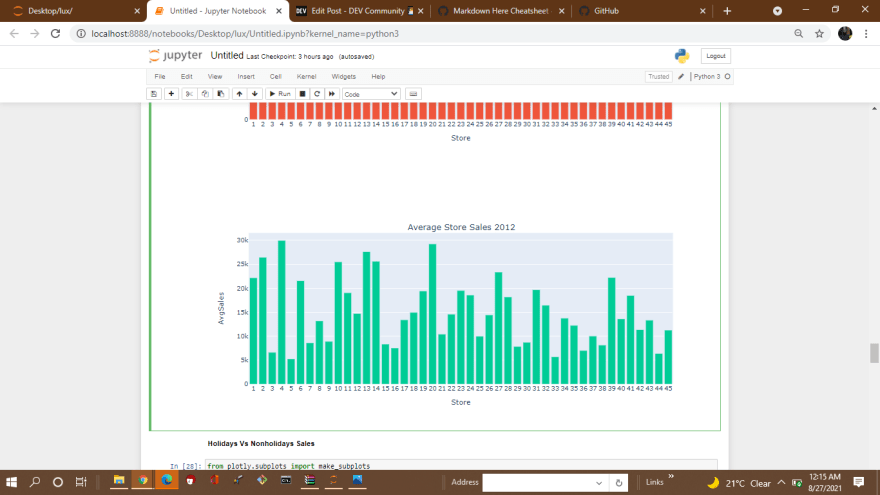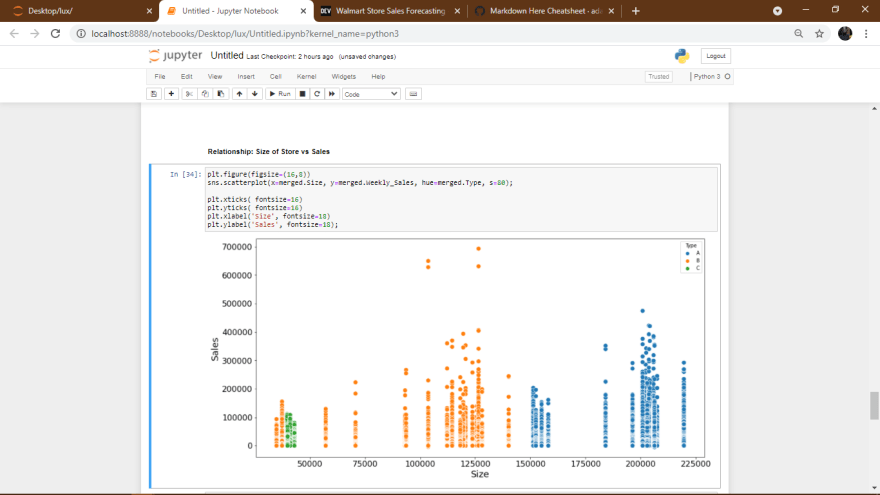An Interest In:
Web News this Week
- April 20, 2024
- April 19, 2024
- April 18, 2024
- April 17, 2024
- April 16, 2024
- April 15, 2024
- April 14, 2024
Walmart Store Sales Forecasting
The walmart dataset provides historical sales data of 45 stores of Walmart, each having various departments.
The objective of this project is to:
- Predict the sales across various departments in each store.
- predict effect of markdowns on sales during the holiday.
We will import necessary packages as follows:
import numpy as npimport pandas as pdimport matplotlib.pyplot as pltimport seaborn as snsimport plotly.express as px%matplotlib inlineData Preparation
The dataset contain the following files in the csv format:
train.csv : this file has 421570 rows and 5 columns. The columns contain the information for a store, department, date, weekly sales and whether a particular week is a holiday week or not
store.csv : this file has 45 rows and 3 columns. The columns correpond to the stores, their type and sizes of stores
features.csv : this file 8190 rows and 12 columns. This file again has some further information regarding the stores and the region in which a particular store is located. It has date, temperature, fuel price, consumer price index, unemployment rate information for the region in which a particular store is located. It also has 5 columns MarkDown1-5 which corresponds to some promotional activities going on in different stores.
walmart = pd.read_csv('train.csv')stores = pd.read_csv('stores.csv')features = pd.read_csv('features.csv')testing = pd.read_csv('test.csv')Merging of Data
Let's merge the data from 3 dataframes into a single dataframe and proceed further with a one dataframe.
merged = walmart.merge(stores, how='left').merge(features, how='left')testing_merged = testing.merge(stores, how='left').merge(features, how='left')Extracting Date Information
The sales are given for Years 2012-2012 on weekly basis. So let's split the date column to extract information for year, month and week
def split_date(df): df['Date'] = pd.to_datetime(df['Date']) df['Year'] = df.Date.dt.year df['Month'] = df.Date.dt.month df['Day'] = df.Date.dt.day df['WeekOfYear'] = (df.Date.dt.isocalendar().week)*1.0 split_date(merged) split_date(testing_merged) Columns Information: Data Types
merged.info()- Most of the columns in the data are numeric columns except the IsHoliday which is of boolean type and Type represents an object
Missing Values
missing_values = merged.isna().sum()px.bar(missing_values, x=missing_values.index, y=missing_values.values, title="Missing Values", labels=dict(x="Variable", y="Missing Values"))From the above plot;
Markdown1-5 contain lots of missing values, more than 250000 in each markdown column.
Exploratory Data Analysis.
Popularity of Store Types
Insights;
Type A stores are more popular than the B and C types
Average Monthly Sales - Per Year
Insights
Month of January witnessed the lowest sales for 2011 and 2012 while for 2010 the weekly sales are not given in the data.
From Feburary till October the weekly sales nearly remains constant around 15000 for the 3 years.
November and December showed the highest sales for 2010 and 2011 while for 2012 the sales data has not been provided.
As shown below;
Average Weekly Sales - per Year
Insights
- 2012 week 14 recorded the highest sales as compared to other weeks.
- Thanksgiving holiday and one week before Christmas witnessed the highest sales for the years 2010 and 2011.
As shown;
Average Department Sales
Different departments showed different levels of average sales
Average Store Sales - Year Wise
- The overall trend of store sales over the 3 years remain the same as it depends on the type of store and its size.
Holidays Vs Nonholidays Sales
*Despite being the less percentage of holiday weeks the sales in the holidays week are on the average higher than in the non-holiday weeks.
Relationship: Week of Year vs Sales
Weekly sales increases towards the end of the year as shown;
Relationship: Size of Store vs Sales
- The sales generally increases with increase of size of store.
Relationship: Fuel Price vs Sales
- Between fuel price and the sales there doesn't seem to exist any clear relationship.
Relationship: Unemployment vs Sales
- Unemployment rate doesn't seem to have any effect on the weekly sales.
Correlation Matrix
Lets now study the relationship between the different columns numerically to check how they correlate with the weekly sales in order to confirm the inferences we have gathered from the above EDA study.
To carry out Correlation Matrix we will first convert the 'Type' column to numerical values as shown;
storetype_values = {'A':3, 'B':2, 'C':1}merged['Type_Numeric'] = merged.Type.map(storetype_values)testing_merged['Type_Numeric'] = testing_merged.Type.map(storetype_values)Insights obtained from above correlation matrix are;
- Department, Store size and Type have moderate correlation with the weekly sales
- Markdown1-5 have very weak correlation with the weekly sales, so we will leave these columns out
- Temperature. Fuel price, CPI and Unemployment are very weakly coorelated with the weekly sales, so these columns will also be dropped out
- IsHoliday will be considered for the further analysis as the sales in the holiday weeks are higher than in the non-holiday weeks
- We will also leave out Month and Day as this information is already contained in the WeekOfYear.
Data Preparation for Model Training.
Following steps will be performed for preparing the data for the subsequent model training.
- Based on the EDA and Correlation study, the columns with weak relationship with the target column will be dropped
- Input and Target dataframes will be created
- Inputs will be scaled in the 0 to 1 range
- Training and testing datasets will be created
- Generate predictions on training data
merged = merged.drop(['Date', 'Temperature','Fuel_Price', 'Type', 'MarkDown1', 'MarkDown2', 'MarkDown3', 'MarkDown4', 'MarkDown5', 'CPI', 'Unemployment', 'Month', 'Day' ], axis=1)testing_merged = testing_merged.drop(['Date', 'Temperature','Fuel_Price', 'Type', 'MarkDown1', 'MarkDown2', 'MarkDown3', 'MarkDown4', 'MarkDown5', 'CPI', 'Unemployment', 'Month', 'Day' ], axis=1)Identify input and target columns.
input_cols = merged.columns.to_list()input_cols.remove('Weekly_Sales')target_col = 'Weekly_Sales'X = merged[input_cols].copy()y = merged[target_col].copy()Scale the values
from sklearn.preprocessing import MinMaxScalerscaler = MinMaxScaler().fit(merged[input_cols])X[input_cols] = scaler.transform(X[input_cols])testing_merged[input_cols] = scaler.transform(testing_merged[input_cols])Create training and testing sets
from sklearn.model_selection import train_test_splitX_train, X_test, y_train, y_test = train_test_split( X, y, test_size=0.3, random_state=42)Machine Learning
We will use Linear regression algorithm.
from sklearn.linear_model import LinearRegression# Create and train the modelmodel = LinearRegression()model.fit(X,y)# Generate predictions on training datatrain_preds = model.predict(X_train)train_predsOutput will be;
array([17035.12035741, 15737.5350701 , 22990.63793901, ..., 20276.77727003, 21110.53004444, 23548.55581834])Original Link: https://dev.to/phylis/walmart-store-sales-forecasting-3ldm
Dev To
 An online community for sharing and discovering great ideas, having debates, and making friends
An online community for sharing and discovering great ideas, having debates, and making friendsMore About this Source Visit Dev To
















